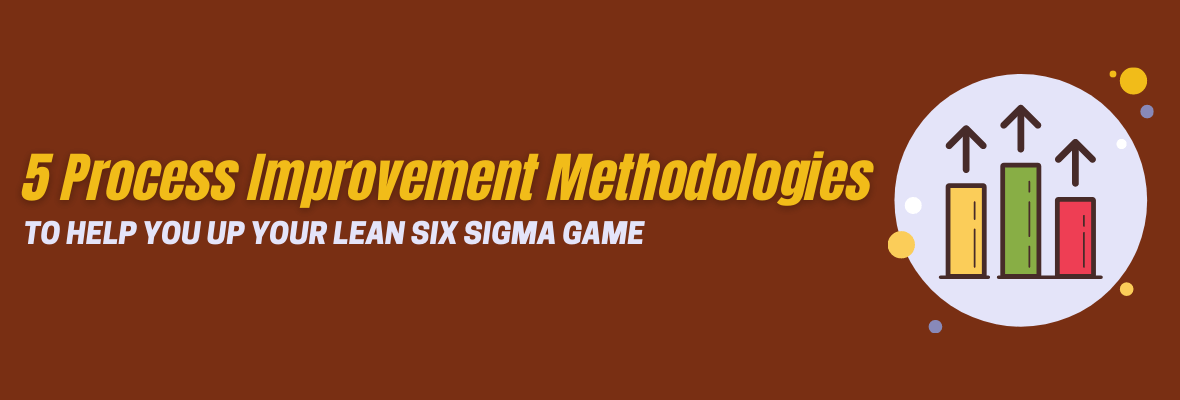5 Process Improvement Methodologies to Help You Up Your Lean Six Sigma Game
Improvement can be personal or professional. Think of your daily life as a process. There are numerous ways you can improve your daily lifestyle and reduce wasting time, lower expenses, find more quality time, and so on. This goes for businesses, too. Process improvement methodologies are important to success in any business.
With process improvement, a business can improve the productivity and efficiency of its employees and operations. It can improve quality, reduce waste, eliminate avoidable expenses, and end up providing better service or products to its customers. Business process improvement methodologies rely on models of continuous process improvement.
Business process improvement has a variety of tools, like business process re-engineering, continuous improvement, business process management, functional process improvement, etc.
Five Crucial Process Improvement Methodologies for Businesses
Process improvement methodologies help organizations to lower costs and inefficiencies while maximizing quality and revenue. Without process improvement, operations can lead to lethargy over time. There may be duplication of efforts in sub-processes, or sub-processes may not be completed in time. The processes may not be equipped to troubleshoot deadlocks and end up missing deadlines.
Without process improvement, there may be a gradual waste of resources as well as deterioration of product quality. So, process improvement tools are crucial to maintaining customer satisfaction, too. Besides, continuous process improvement also ensures improvement in quality of work, which, in turn, helps to keep the workforce motivated.
If an organization aims to implement and continue process improvement methodologies, there are a few that are universally accepted across the world. Five such process improvement tools and methodologies are:
1) Six Sigma
Six Sigma is a methodology designed to bring perfection to the process of product or service delivery. It is a composition of quality management tools and theories that follow a data-driven approach for the removal of deficiencies.
Motorola, the pioneers of Six Sigma, considers it as a measurement system, methodology, and management system. There are two sub-methodologies, which implement the Six Sigma framework. The DMAIC methodologies improve existing processes while DMADV is for the creation of new processes.
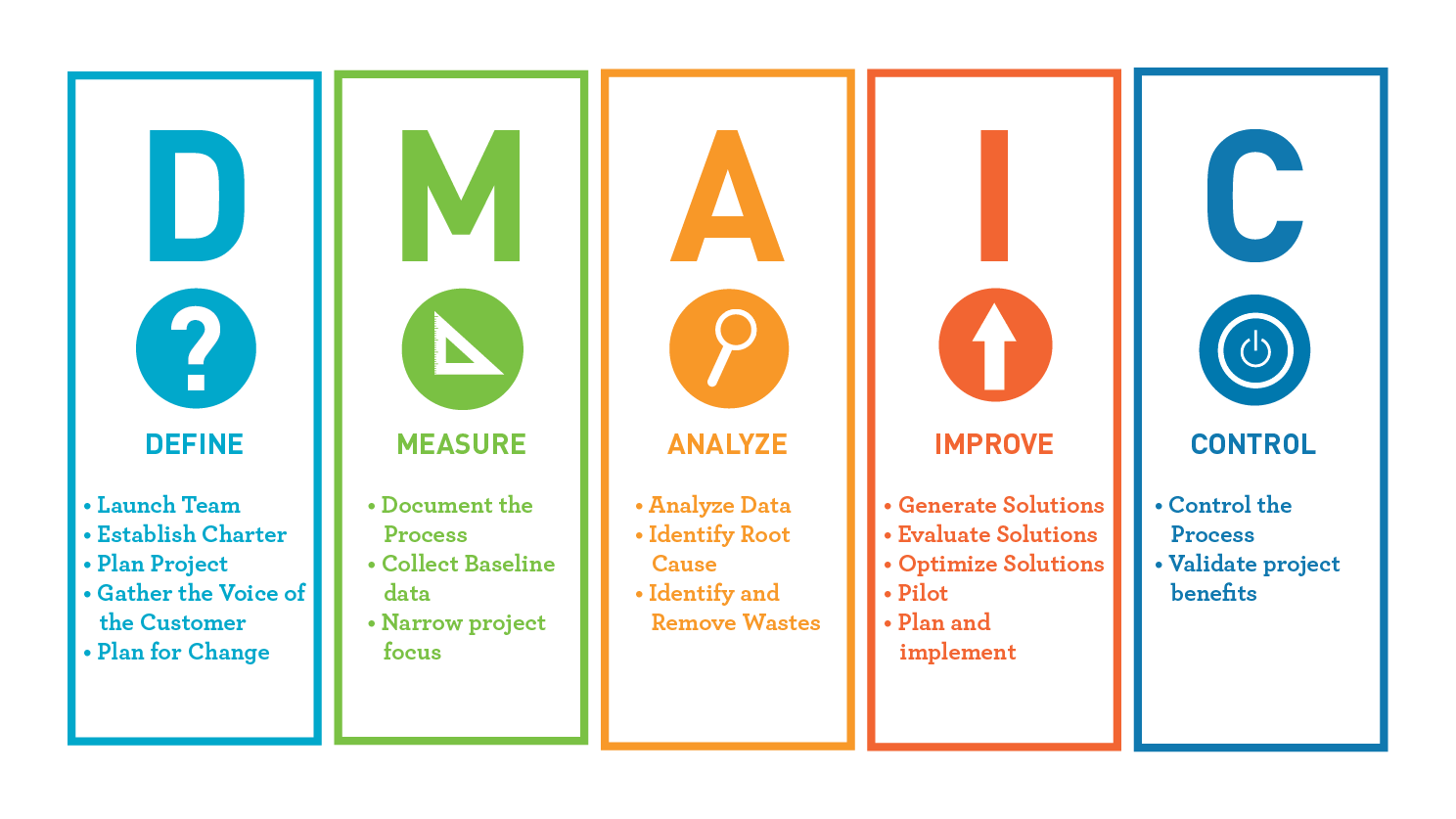
Source: GO Productivity
DMAIC comprises of the following steps:
- Define – defining the project goal where the opportunity for improvement lies;
- Measure – refers to the performance measurement of the existing process(s);
- Analyze – here the analysis of the process is to identify the defects and conduct root cause analysis;
- Improve – address the root causes identified to start an improvement in the process;
- Control – the process improvement and future process performance are controlled so that the process owner can avoid deviations and defects.
DMADV steps are similar to DMAIC except for the last two steps.
- Define – the process goal is keeping the company strategy and customer needs in mind;
- Measure – refers to the measurement of the factors that are critical to quality (CTQ);
- Analyze – consists of the analysis of various design and development options;
- Design – is the designing of the new quality improvement process;
- Verify – is the trial implementation of the process to check whether the design meets the goals and customer needs. Once done successfully, the process is implemented.
As apparent from the above, the Six Sigma sub-methodologies cover the entire process improvement and process development life cycle. Through it, you can achieve perfection in your processes and visualize them, keeping the entire gamut of roles, responsibilities, and goals in mind.
2) Lean Six Sigma
While Six Sigma focuses on the reduction of deviations in processes and better control over processes, Lean standardizes work by eliminating waste. Lean weeds out inefficient and non-value-add processes and procedures. Together, Lean Six Sigma acts as a process improvement plan that achieves a competitive advantage for the organization. It prioritizes workflow standardization and aims to improve profitability through reduction in variances, waste, and process cycle time. It also aims to achieve defect prevention, rather than defect detection, and improve customer satisfaction.
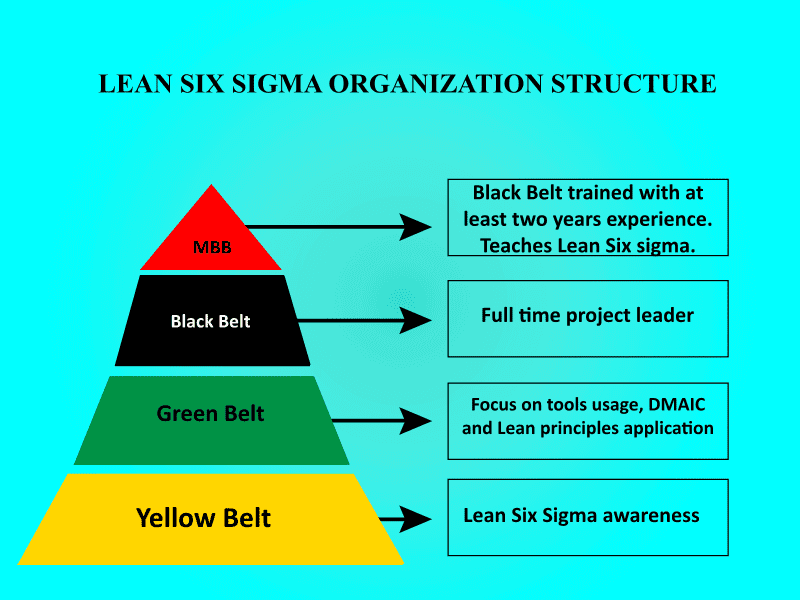
Source: Investopedia
While selecting Lean Six Sigma from among the process improvement methodologies, the organization has to integrate two different methodologies and capitalize on the best of both worlds.
You can achieve the aim of waste reduction through Lean while reducing the process deviations through Six Sigma. With the simpler tools of Lean, an organization can implement its methodologies, to begin with, and then go on to use the more technical Six Sigma tools. Lean tools include visual controls, workplace organization, and kaizen, all of which aim for better work efficiency and effectiveness.
3) Total Quality Management (TQM)
TQM is another of the process improvement methodologies, which rests organization-level importance on customer satisfaction. As its name suggests, quality management is at an organizational level, involving all employees. The focus on quality integrates into the organization’s culture and processes through the use of data, communications, and strategy.
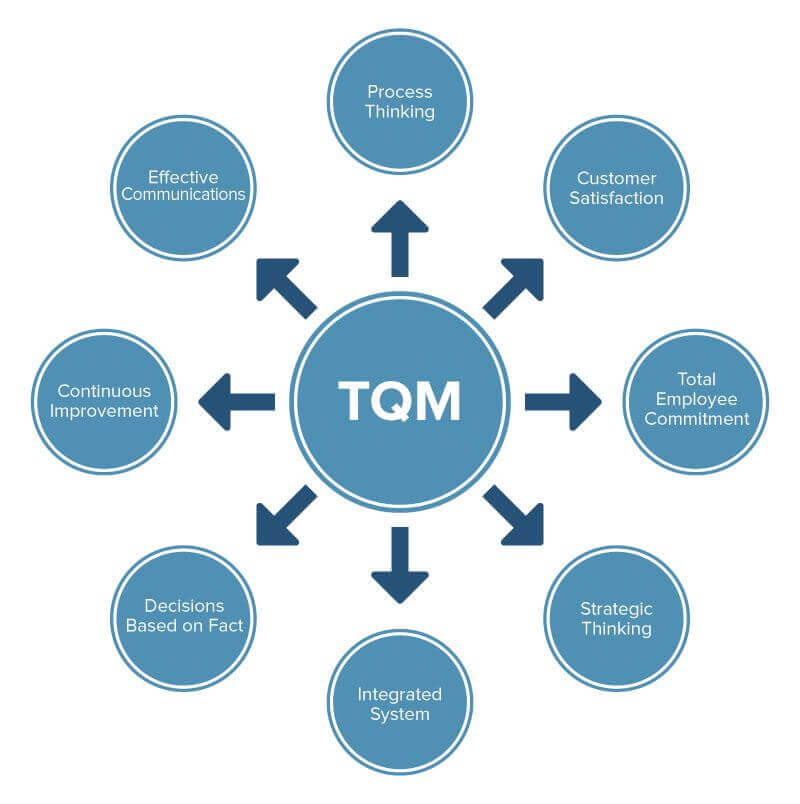
Source: Smartsheet
The key principles that need to be integrated into the organization to implement TQM are:
- Focus on the customer – It is the customer who decides whether the quality of the product/service is fit for the purpose. This methodology acknowledges the importance of customer satisfaction.
- Total employee involvement – Employee empowerment, a high-performance work environment, and the integration of continuous improvement ensure employee participation as a part of regular operations.
- Process thinking – A series of steps carry out a process, and these steps are then monitored to identify and eliminate variances.
- Integrated system – The horizontal process alignment between an organization’s different functions is the focus of TQM. This helps in fostering a uniform quality culture across the organization.
- A strategic and systematic approach considers quality as an important part of the strategic plan.
- Continual improvement – It is important for TQM to show continual improvement, which helps businesses to remain competitive and effective enough to meet customer expectations.
- Fact-based decisions – Performance measuring data is collected and analyzed regularly for predictive insights and accurate decision-making.
- Communications – Use of communications to maintain employee morale, monitor methods and strategies, and ensure timeliness.
With an organizational drive for continual improvement, TQM remains one of the most prominent process improvement methodologies in practice.
4) Just-in-Time
Also known as the Toyota Production System after its pioneers, the Just-in-Time (JIT) methodology aims to save inventory cost and production time through small improvements in the processes. It uses the Kaizen approach, which eliminates large inventory costs by producing only when required. With reduced production time and doing production only on a need basis, the inventory is bought “just-in-time.”
JIT believes in the creation of a stabilized work schedule that is based on long-term vendor and customer relationships. Frequent small purchases establish the norm, with an emphasis on strategic commitment to effectiveness and implementation.
The advantage that JIT provides is its adaptability to process improvement plans in a wide range of business processes, including operations, logistics, supply chain, HR, accounting, etc. it is one of the best process improvement methodologies if you want to eliminate waste and improve quality. It also helps an organization to achieve a lean process improvement in the cost of inventories and their holding.
5) Theory of Constraints
A constraint is present in every organization. It is the limitation or obstacle that stops a company from achieving its goal(s). Theory of constraints (TOC) identifies this constraint, the weakest link, so it can be eliminated.
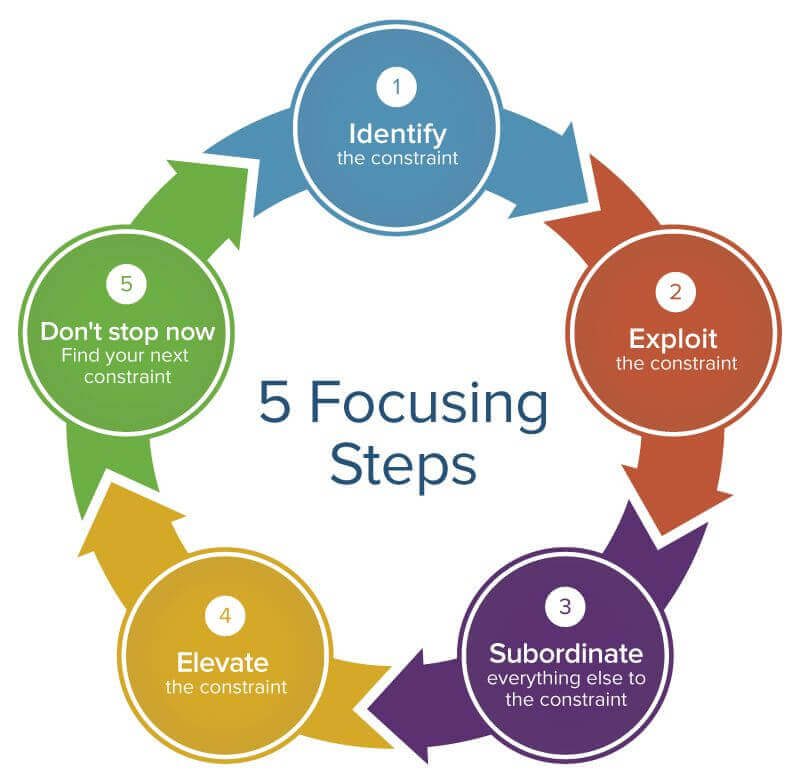
Source: Smartsheet
TOC follows a simple step approach where
- The company identifies the constraint;
- It decides the course of action to diffuse the constraint;
- It sets the non-constraint components in a way the constraint operates at full effectiveness;
- It checks if the constraint shifts to another component;
- If the constraint doesn’t shift, it adopts major changes to eliminate the constraint;
- It repeats this approach if there is a need to identify and address another constraint.
TOC is an ongoing process improvement methodology that has profitability as a key focus area. Its quality improvement process improves the organization’s throughput and reduces costs around inventory and operating expenses.
How Can You Improve Processes With GreyCampus?
The International Association of Six Sigma Certification is the designer of the Lean Six Sigma body of knowledge, including the certified black belt and certified green belt programs. A Lean Six Sigma green and black belt combo training and certification prepare you for both programs.
GreyCampus is an IASSC accredited training organization that provides you access to the authentic course curriculum and the recognition it brings. Enrolling for GreyCampus Lean Six Sigma Bootcamp is sure to provide you with a thorough understanding of all Lean and Six Sigma process improvement methodologies and the DMAIC concept. The program curriculum provides you with the foundational knowledge along with a complete breakdown of the DMAIC model, i.e., Define, Measure, Analyze, Improve, and Control. Let’s find out how this certification and Bootcamp is tailor-made for your Lean process improvement knowledge.
- Live bootcamps – The first advantage you will notice instantly is the live bootcamps, which are ideal for a practical experience of process improvement methodologies. This is ensured through self-paced courseware that leading Lean Six Sigma instructors conduct.
- Simulated exams – The simulated exams also add to the real-life Lean Six Sigma experience. These exams help you to regularly implement your learnings in practical scenarios. You also get round the clock support to answer all your doubts and queries about the course and its concepts. You even get a dedicated instructor helpline. This mentorship helps you to perform well in both green and black belt exams.
- Gamified Learning – With gamified learning modules and tutorial videos, GreyCampus Lean Six Sigma certification combines thorough coverage with a realistic set of study material. You have access to these materials even when you are offline.
Once you complete the Lean Six Sigma Green & Black Belt Combo Training & Certification, you receive a Certificate of Credit for 80 PMI PDUs. Also, GreyCampus provides you with the Course Completion certificate and a Certificate of Achievement.
Summing Up
Process engineers evaluate the relative advantages of these methodologies while selecting one of them for process improvement. They can go for the data-driven approach of Six Sigma, or the cost and waste minimization techniques of Lean and JIT. If they prioritize continuous improvement and customer quality, the organization-wide implementation of TQM serves their purpose. TOC, on the other hand, identifies specific constraints and addresses them systematically.
Want To Nail Process Improvement Methodologies? Join a Bootcamp Today!
